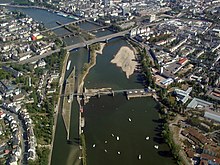Barrage
A barrage is a system for damming a river in order to regulate the water level upstream and downstream. Usually there are several barrages one behind the other in a dam- regulated river section. A common reason to build a barrage is to make it easier to navigate and to generate electrical energy through run-of-river power plants .
In contrast to a dam , the dam is usually a dam that essentially only blocks the river and not the entire width of the valley. It consists of a weir and possibly a hydroelectric power station and a ship lock system . Above a congestion level is the congestion attitude that occasionally a lake-like extension ( reservoir ), and is bounded laterally depending on the terrain of impoundment dams.
Depending on the design, a distinction is made between different weirs:
- Controllable (movable) weirs:
- By installing control organs (weir locks), including pull and pressure segments, attachment flaps and contactors , the water level in the weir's headwater can be controlled as required.
- Non-controllable (fixed) weirs:
- The weir consists of a rigid, unchangeable damming body without regulating devices.
Larger weir systems are usually equipped with several weir fields with weir locks (control organs) that can be operated separately from one another. For safety reasons, weirs should have one more field than necessary ( n-1 rule ) so that one can fail safely as a result of revision or blockage in the event of floods.
Barrages on navigable waters have sluices to enable navigation to overcome the difference in altitude.
In order to ensure the continuity of the flowing water for aquatic organisms, bypass channels or fish ladders are increasingly being arranged, or part of the weir system is designed as a gently sloping, rough ramp.
Examples of navigable rivers regulated by barrages are:
- Upper Rhine between Basel and Iffezheim
- Main , see the list of main stages
- Moselle , see the list of Moselle barrages
- Elbe above Ústí ( Aussig )
- Danube between Jochenstein and Vienna (details: Österreichische Donaukraftwerke AG )
- Neckar between the confluence with the Rhine and Plochingen , see the list of Neckar barrages
- Weser between Petershagen and Bremen
Very small barrages are used to measure the discharge ( level ). The height of the water level above the overflow provides information about the amount of water flowing off. The overflow of a level usually contains a triangular recess for small amounts of water.
See also
literature
- DIN 4048-1 Hydraulic engineering, terms, dams; January 1987
- DIN 4054 hydraulic engineering, terms; September 1977


